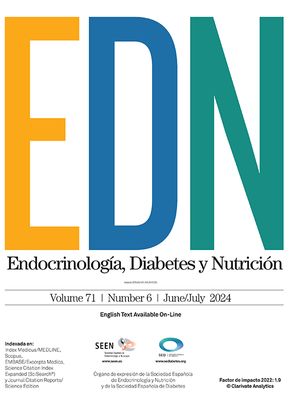Prader-Willi syndrome (PWS) is a genetic disease caused by the loss of expression of genes of paternal origin in the region 15q11–q13 of chromosome 15. The main characteristics of the syndrome include neonatal hypotonia, feeding problems in infancy, characteristic facies, intellectual disability, behavioral changes, GH deficiency, hypogonadism, and hyperphagia. Hyperphagia leads to the development of obesity at an early age, which, together with its complications, is the main cause of morbidity and mortality in PWS.1
PWS is the leading genetic cause of obesity. Despite this, it is a rare disease, with an incidence of approximately 1:10,000–1:30,000 of the population.1 It could therefore be relegated to the group of rare diseases, trying to awake the interest of a few people. This is however a model of extreme obesity whose main feature is hyperphagia, and is therefore an excellent model to investigate the complex mechanisms regulating appetite.
Two different nutritional stages have traditionally been reported in children with PWS: a first stage during infancy marked by feeding and growth difficulties, and a second stage where hyperphagia starts and leads to development of obesity. The process is however more complex than it seems, and up to seven different phases have been reported in recent years.2 Among these, it should be noted that, unlike it could seem, weight gain precedes hyperphagia, and therefore starts before calorie intake increases.
In addition, in subjects with PWS, as compared to obese and healthy controls, intake velocity is continuous and constant, with no deceleration, so that food intake lasts longer. They finish eating later and are hungry again sooner. The key appears to be lack of satiety, rather than excess appetite.3
As regards peripheral signals regulating satiety, various peptides and hormones have been studied in the past decades in patients with PWS, adults and children in both fasting and postprandial conditions. None of them may account for hyperphagia alone, but probably many of them play a role in its development. For example, normalization of high levels of ghrelin, an orexigenic hormone, reported in PWS by somatostatin treatment has not been shown to decrease intake in these patients.4 Similarly, although both fasting and postprandial levels of pancreatic polypeptide (an anorexigenic peptide) are low in subjects with PWS, the result of infusion of this peptide is controversial.5
With regard to other intestinal peptides with an anorexigenic action such as GLP-1 and cholecystokinine, no differences have been found between subjects with PWS and controls.6 The relationship between PWS and other anorexigenic peptides such as peptide YY, pancreatic polypeptide, or amyline is also complex. Some studies have been able to show decreased fasting levels of peptide YY and a truncated postprandial response that could contribute to the lack of satiety and could also be related to the lack of ghrelin decrease.7 To date, amyline levels in children with PWS have only been tested in one study,8 which reported low levels after intake as compared to obese controls which could contribute to the lack of satiety. Finally, brain-derived neurotrophic factor (BDNF) levels in children with PWS have been reported in a single study.9 BDNF, a neurotrophin involved in neuronal development and plasticity, has been implicated in appetite control through inhibition of orexigenic hormones in the hypothalamic arcuate nucleus. In the above-mentioned study, low fasting BDNF levels were seen in children with PWS as compared to obese and healthy controls.
At central level, postmortem studies noted a decrease in the number and volume of oxytocin-secreting neurons (which play an anorexigenic role) in the hypothalamic paraventricular nucleus in subjects with PWS as compared to healthy subjects.10 No changes have been found in other neuropeptides and receptors studied, such as neurons NPY/AGRP or POMC/CART. Neuroimaging studies have also shown differences in the height of adenohypophysis in patients with PWS as compared to healthy subjects, radiographic absence of the posterior pituitary gland, or other pituitary changes.11
In recent years, functional neuroimaging using techniques such as PET and MRI has opened up new possibilities to study brain regions implicated in appetite control. Thus, lack of activation of areas related to satiety after intake has been suggested in subjects with PWS, as well as increased activation of areas related to hunger and motivation (hippocampus and orbitofrontal cortex) when viewing hypercaloric versus hypocaloric food.12 It appears that activation of these areas in PWS is not only abnormal in response to food stimuli or in the postprandial state, but also in the basal state, in which impaired connectivity between brain regions implicated in intake and reward has been reported.
As previously noted, none of these mechanisms may explain hyperphagia in PWS by itself. Hyperphagia probably reflects dysfunction of multiple appetite inhibition and satiety control systems. In the coming years, additional data are expected to become available about the peripheral signals involved in appetite control, particularly those for which less information is now available, as well as additional information on the brain networks involved in the process coming from functional neuroimaging studies. Thus, although an increasing number of pieces in the puzzle are known, there are probably many to be discovered yet and, more important, the mechanisms relating them should be found.
Fondo de Investigación Sanitaria. Instituto de Salud Carlos III. PI 10/00940 (Study of cerebral functional connectivity in food motivation networks in adult patients with Prader-Willi syndrome).
Please cite this article as: Bueno Díez M, Caixàs Pedragós A. Síndrome de Prader-Willi e hiperfagia: un reto a investigar. Endocrinol Nutr. 2014;61:121–122.




